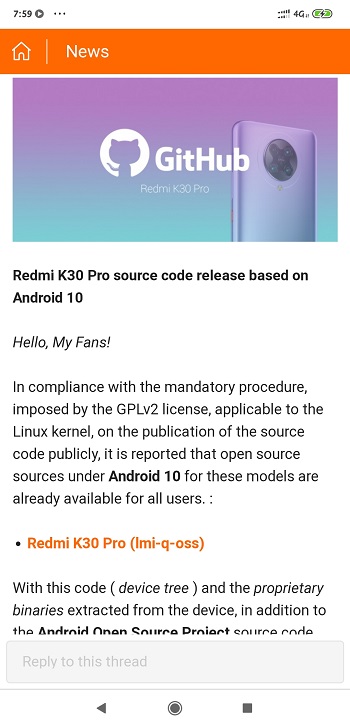Android being an open-source project means that developers can freely create a custom firmware and after-market system software for many of the Android devices out here, thereby enabling the bustling Custom ROM ecosystem and developer forums that we see today.
However, the success of any of these third-party, after-market firmware is still heavily dependent on the phone-makers as they’re the ones who hold the devices’ kernel source code. This Kernel source code, unlike AOSP, is proprietary binary and is device-specific, meaning only the device-maker Some OEMs are more friendly than others when it comes to making this public.

Users and developers of the Redmi K30 Pro and the Samsung Galaxy Fold 4G have a reason to celebrate as the respective companies just made official the Kernel Source Code for both devices on Android 10.
What this essentially means is that the developers can now start building more stable and tailor-made custom ROMs for these two devices among other interesting things.

In the release notes, Xiaomi says that this Kernel Code should go to help developers build better custom ROMs for the Redmi K30 Pro based on the also Open Source Android Open Source Project.
The Kernel Source Code has since been made public and is readily available to the public on Xiaomi’s MiCode GitHub page. You can access or download the whole code using this link.
Samsung’s Galaxy Fold, at least the 4G variant of it, also has its kernel source code made public. This means that custom ROM developers can now go on to develop tailor-made and device-specific firmware for this device.
The kernel source code for the Galaxy Fold can be downloaded from Samsung’s Open Source website here. At the time of writing, the kernels that have been made public are for the F900FXXU3BTCD, F900FXXS3ATA3, F900FXXU2ASKB, and the F900FXXU1ASJ4 models of the Galaxy Fold.
On a different front, LineageOS is available for the Asus ROG Phone II. To recall, the ASUS has recently been updated to Android 10. However, that didn’t quite go well because, soon after the update hit devices, users started complaining about a bunch of system issue that they were not facing before the update.

We have listed and outlines some of these issues in this post. Granted, ASUS has come out to try to help these affected users as much as possible, but many of these issues still persist. While chances are that an update might be pushed out to fix many of these issues, experimental users might want to try out this build of Android 10-based Lineage OS 17.1.
Also getting a build of the latest Android 10-based Lineage 17.1 is the Wileyfox Swift. This is still an unofficial build and is still in its Alpha build stages. This, therefore, might not exactly be daily-driver material.
The after-market firmware ecosystem for Android devices is a rather active one with forums like XDA developer being a hub for many of these developments. These offer so much value for Android devices and opens a whole new level of customization.
PiunikaWeb started as purely an investigative tech journalism website with main focus on ‘breaking’ or ‘exclusive’ news. In no time, our stories got picked up by the likes of Forbes, Foxnews, Gizmodo, TechCrunch, Engadget, The Verge, Macrumors, and many others. Want to know more about us? Head here.



